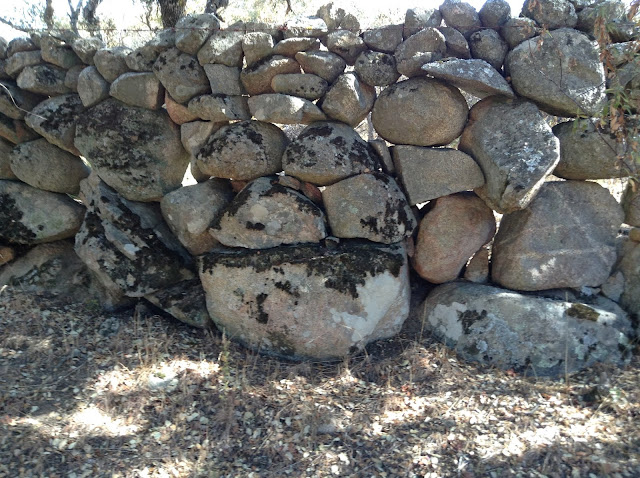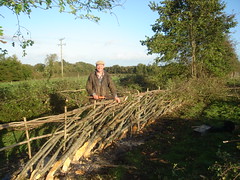This was going to be easy. I'd been asked to write an article on Dry Stone Walling and Google for Sean Adcock of the North Wales Branch of the Drystone Walling Association's magazine Stonechat.
"Punch “drystone walls” into Google and go through them – see what is out there – good and bad".
Page 1 until ? Well, I gave up the careful prowl at around page 20 of google results and started page hopping until I gave up at page 35 when my browser refused to open any more sites.
So what did I discover? Well,, most surprisingly was the fact that most sites I turned up were entirely as you would expect in that they were relevant and mostly quite good. Along the way I discovered a few odds and ends. I discovered that in answers at Yahoo.com a thread which stated a stone wall would cost to build anything from £30 to £300 per metre depending on who you believed. I also found a wall costing only £4.99. I found out you could attend a drystone walling course in Switzerland for £435 including 3 nights full board & breakfast at www.myswiterland.com. I also discovered the Catalan for drystone waller is “Margerer”
As you probably have already discovered, a search on google produces mostly waller’s own websites, several dswa pages, amazon books and rather amusingly a few portal sight which lists areas with drystone wallers in it. Swiss Cottage in London was listed and isn’t known for it’s walling traditions so I couldn’t resist a quick visit. It listed three walling sites, one of which was a quarry in the Black Mountains an address in Armagh which is in Ireland so I had a look to see what was going on there. (Nothing). An address in surrey turned out to be a builders merchang so I’m still trying to work out the link with Swiss Cottage. I pressed the back button.
The first interesting site was “Sticks and Stones’, http://www.omlxi.com/sticks_stones/index.php a Tasmainian site by two gents. One a waller, the other a hedgelayer. Yes, both are practised in Tasmania even if only by these two and you can see their work.
By page 5 some odd drystone walling sites appear. Attracted by www.opendemocrfacy.net and it’s appealing, ‘Reshaping The Dry Stone Wall of Irish history’ title I gave it ago. After all I’d lived there for 10 years and never, ever come across this book. The book’s description was as follows:, “This book of twenty-five chapters is a selection of papers presented at a conference organised by the British Association for Irish Studies held at the University of Salford in September 2005. An additional commissioned chapter deals with the fortunes of the two major Unionist parties since the Belfast Agreement of 1998, in particular tracking the transition of the Democratic Unionists from opposition to the ‘Trimble-Adams Pact’ to miraculous support for a Robinson-McGuinness Executive. Appropriately, the book retains the diversity of the papers’ subject matter and, in keeping with recent academic...” Back space again!! I eventually worked out the relevance of the title with help from Trish. I’ll leave you to work it out too. Good luck.
On page seven I turned up http://www.newgrounds.com/portal/view/412167 an animated video of “Old Man Pie” building a wall. Stupidly I expected an instructional video but it turned out to be an animated video almost showing wall building. Don’t bother but good if you like watching or listening to something pointless. “I build a wall around my home, It keeps out enemies and friends”. Oh, go on I suppose it was a bit of fun after all!
In total contrast and well worth looking at is the video by Mick Soft at http://www.youtube.com/watch?v=UIHc09Z5hvw. It’s a good micky take at wallers who talk about walling in some kind of hushed and referential manner. .The man does not confine his wit to us wallers either. If you follow the links watch his take on tree surgeons too.
A site known to many is Norman Haddow’s blogspot
http://wallswithoutmortar.blogspot.com and is a simple blog containing many excellent pictures and articles on walling from many countries. Well worth the visit. This site is an education in itself.
Another interesting site http://www.astoneuponastone.com/ the home of the Drystone walling association of Australia. Lots of pictures of.....errr,,, Australian Walls!
The first techno site I found with an extensive report on the strength of drystone walls, conducted by the University of Bath, can be found at http://www.bath.ac.uk/ace/dry-stone-2/
Of real interest to us wallers and probably well know is The National Stone Centre, especially the Millennium Wall at http://www.nationalstonecentre.org.uk/vs_millenniumwall.html. Numerous walls from around the UK built in regional styles using stone from around the UK and of course built by many different wallers from around the UK.
For those wallers who actually turn up to give an estimate then this site http://www.lowimpact.org/products_dry_stone_walling.html offers a solution. Just send them as many details as you can and they’ll give an estimate of the cost for them to build. This company would be a welcomed contributor to regular enquiries on the DSWA forum when it comes to questions of costs and speeds.
On the web you can also buy a complete Flexible drystone wall from JAVIS-JSTONEOOS-FLEXIBLE-DRY-STONE-WALLING and it will only cost a pound or two. But before you get excited it turned out to be the sort you get in a plastic bag and use on model railways and the like. I found another one advertised as, ‘suitable for model railways’ at £4.99.
The MPs have also been claiming for stonework. Janis Anderson Rossingdale MP paid several hundred pounds for walling on her home. (I’m not sure which one!) read more here in the Manchester Evening News http://www.manchestereveningnews.co.uk/news/s/1121367_janet_andersons_dry_stone_wall
As we go further into google some new and unexpected stuff comes up This University of Huddersfield page http://eprints.hud.ac.uk/4729/ provides us with an extract from a thesis entitled, “Tacit knowledge, learning & expertise in drystone walling” (Farrar, Nicholas Stewart 2006) Reading the extract was interesting and one day I’ll get around to reading the whole thesis which can be read by clicking the link. At 277 pages you’ll be doing a lot of reading – in fact you’ll get to page 134 before you meet a wall or even a waller. On page 243 there are some useful lessons in support of the DSWA walling qualifications.
If you want an expensive book on stonewalling try Colin Sowerby’s http://www.thedrystonewaller.com/products.htm 6 pages for £5, an e-book claiming to be a concise guide to walling. Obviously some of us know far too much for our own good.
Flikr interestingly didn’t come up until page 20 and there are thousands of pictures which I’ll let you trawl through at your leisure.
The stone foundation www.stonefoundation.org an american site worth a visit even if I found the navigation a little confusing.
There are a number of good sites describing how to build a wall. But by far the worse is this one http://homeideas.howstuffworks.com/walls-and-boundaries/how-to-approach-building-a-dry-stone-wall.htm. If you are a knew nothing before looking at this site you’ll still know nothing afterwards.
You can even watch a stone wall being repaired. By invisible people no doubt at http://www.byrdir.co.uk/wp-content/uploads/2008/09/stonewall.gif
Way down the listings on page 18 or so was this european site http://www.conselldemallorca.net/mediambient/pedra/pedraensec.php?idioma=ing&opcio=1 A Mallorca based site, of which a large portion is devoted to the rebuilding and conservation of their drystone walls and structures and is available in several languages which perhaps is a reflection on the recognition of the world wide interest in drystone walling. Conservation isn’t just a British thing!
And so on. I got to page 34 on google before my PC started to have a bad internet day but not before I noticed, “Taylors Master Guide to gardening which stated that “Drystone walls are ideal for gardening as they give when the ground moves as it freezes in winter.”
I’ll end my tedious tour here as the last paragraph could promote some discussion amongst anorak clad wallers. Oh, and if anyone does discover some really truly awful walling sites please let Sean know, because I couldn’t find them!
 On Sherkin Island, just off the coast of Cork in SW Ireland you can find some of the most unusual dry stone walls anywhere.
On Sherkin Island, just off the coast of Cork in SW Ireland you can find some of the most unusual dry stone walls anywhere.
 And so several weeks passed before I had the opportunity. The wall runs for just a couple of hundred yards along the top of steep cliffs. It was built to keep cattle from straying over the cliffs.
And so several weeks passed before I had the opportunity. The wall runs for just a couple of hundred yards along the top of steep cliffs. It was built to keep cattle from straying over the cliffs.
































